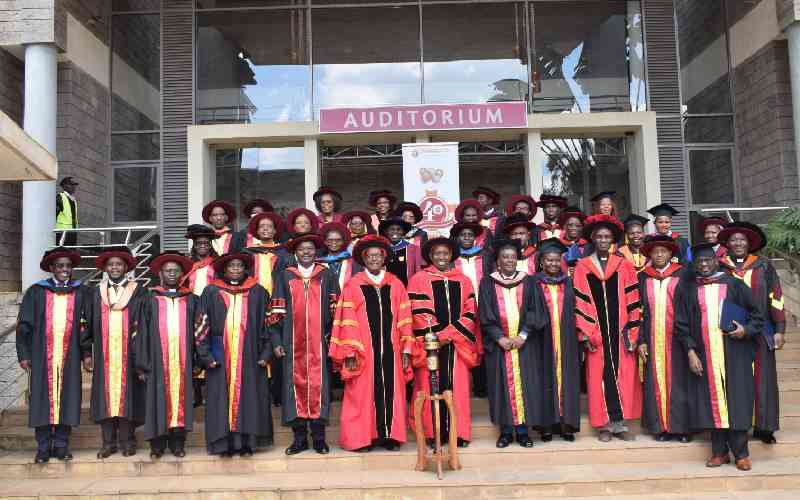 |
|
Kisumu in the early 1980s. [PHOTOS: FILE/STANDARD AND COURTESY] |
By Amos Kareithi
Like an irresistible beauty, Kisumu, the port city, has for hundreds of years attracted the attention of the mighty and the meek. Suitors from near and far have trooped to her, and even fought, hoping to win her favour.
For more than 100 years, Kisumu has refused to be ignored; continuing to court affection and controversy in equal measure.
This, and the city’s resilience, has made it stand out just like the mighty actions of its gallant soldiers continue to reverberate through the ages.
These echoes of its thunderous past paint a picture of a city whose people have learnt to weather storms. The storms have inspired a number of revolutions that have contributed to the shaping of Kenya’s political path.
A peek into the origins of Kisumu City shows that it is one of the oldest settlements in the country. Historical records indicate that Kisumu has been dominated by diverse communities at different times.
Unlike other major towns that are only 100 years old at best, Kisumu was a human settlement more than a century before Europeans came to East Africa.
New life
Many battles had been fought, won and lost in the theatre of conflict before the railway head reached the port and breathed a new lease of life into the area.
Modernists believe that Kisumu was founded in 1898 after the coming of the Imperial British East African Company’s agents. The company preceded the British government in the administration of what became the East African Protectorate.
According to this theory, Kisumu’s fortunes changed for the better on the Friday of December 20, 1901, when the railway finally reached Port Florence, as the city was known then.
This momentous arrival not only upgraded it to a railway terminus, but also enabled it to overshadow previously prominent towns such as Mumias and Port Victoria.
However, historians have demonstrated that long before the coming of the white man, there existed a human settlement in the place where the city stands today. This was the cause of much competition between rival clans and communities.
Historian Bethwell A Ogot says the city was founded by the Kisumo clans, who were the first of the Luo clans to migrate to what is today known as Nyanza. It is interesting that the clan adopted the name Kisumo, which in Dholuo means ‘a place where the hungry came to beg for food’.
The Kisumo clan was led by Ramogi Ajwang’, who initially established a settlement on the slopes of Yimbo hills, between 1500 and 1600, according to Ogot’s calculations.
Stay informed. Subscribe to our newsletter
It is possible that the clan, which was a component of Jok-A-Jok group and had migrated through northern Uganda, passing Gulu and Soroti before entering what we know today as Kenya.
Marauding bands
At the time, they were led by Moth son of Omwa, following the passing away of Omwa, who died of old age.
Ogot’s theory is expounded by Prof William Robert Ochieng’ in Historical Studies and Social Change in Western Kenya: Essays in memory of Prof Gideon S Were.
According to Ochieng’, the original inhabitants of Kisumu, the Kisumo people, had lived in the area for about 200 years as farmers, herdsmen and hunters, when they were forced to migrate to Alego by marauding Kalenjin bands.
However, around 1820, the Kisumo people led by Ajwang’ from Kamoth, Nyaoke from Karateng’ and Odula from Kanyijowi, attacked the Gem Rae people who were occupying Kisumu at that time, and successfully drove them to the Kano plains.
Despite this victory, the Kisumo people had to contend with the persistent raids of the Kajulu and Nandi people who lived near Kisumu.
Ochieng’ explains that the hostility between the Kisumo people and the Banyore, Maragoli and Nandi was such that they had to fortify their homes. Some remnants of these fortresses, locally known as ohinga, remain in Obiero and Rarondo.
Around 1880, the Kisumo people had already expanded to Kondele and Kibuye areas, while most of the area today known as Kisumu City was covered by dense forests where wild animals roamed freely.
At around 1900, when the white man was just about to arrive in the region, there was a severe food shortage, which saw hundreds of people flee the area while the people of Kisumo resorted to banditry for survival. They formed gangs, which were led by ruthless men such as Chilo Kawere of Kanyamony, Okore Chieng’ Ogada and Otiende Luoch Akako.
Paramount chief
Before the arrival of the white man, the inhabitants of Kano plains had devised a new method of keeping their quarrelsome neighbours at bay; guns bought from Swahili and Arab traders, who passed through their territory on their way to Uganda.
They used these guns to terrorise the Kisumo people. One such raid ended the illustrious career of Otiende Luoch of Kisumo.
Ironically, it was Kano that later brought the Kisumo people into contact with the white man. The Kano ruler, Kitoto son of Chama, led British administrator C W Hobley to the home of Ogola, the leader of the Joka-Rateng’ group, in Karateng’. This was later followed by some visits to Hobley’s base in Mumias.
At first, Hobley, who had no understanding of the structure of leadership in the area, wanted to make Ogola the chief, but he was informed that the real leader of the Kisumo people was Ogada. This is how Ogada landed his post as the first colonial chief of Kisumu.
Ogola’s relationship with Hobley was lasting, and the administrator later treated him as the paramount chief of all the Luos.
When a Reverend J J Willis arrived in the area in 1906, Ogola granted him land, where he founded the famous Maseno School. It was called Maseno because the spot Wills was shown had a gigantic Oseno tree.
Nagging problems
Hobley later shifted his base from Mumias to Kisumu, setting the port city on the path to being the seat of government in western Kenya.
According to a report, The History of Kisumu, Situation analysis of Informal Settlements in Kisumu, some of the most nagging problems bedeviling the city started 105 years ago in 1908, when a bubonic plague swept across the area. This and other challenges led the colonial government to divide the town into three zones.
Block A, was exclusively for the official residence of the colonial officers, government and railway headquarters. It was in this block that prison, police medical and post office workers as well as Indians and Europeans resided.
To ensure that the white settlers were not contaminated by Africans, the colonial authorities established a buffer zone, which they called Block B.
Africans were confined to Block C. This area would later propel the growth of informal settlements for there was no proper planning and no effort was made to establish the required infrastructure.
Time bomb
Owing to the rapid growth of the African zone, the colonial authorities reduced the size of the town in 1930, to make it more manageable. The Africans responded by developing semi-permanent structures. These structures, described by planners as a ‘time bomb’, have metamorphosed into more informal settlements.
The most prominent informal settlements are Manyatta, Kondele and Nyawita, the home to many members of Kisumu’s army of casual labourers, as well as the unemployed.
These areas have kept the spirit of some of the ancient raiders alive, for they offer refuge to the city’s criminal gangs.
After 115 years of existence as a modern city, Kisumu is on the threshold of realising its potential for it has earned semi-autonomy under Governor Jack Raguma.
Perhaps in the new devolved system of governance, Kisumu will live up to its name of being a refuge where investment hungry entrepreneurs will flock.
The writer can be reached on [email protected].
 The Standard Group Plc is a
multi-media organization with investments in media platforms spanning newspaper
print operations, television, radio broadcasting, digital and online services. The
Standard Group is recognized as a leading multi-media house in Kenya with a key
influence in matters of national and international interest.
The Standard Group Plc is a
multi-media organization with investments in media platforms spanning newspaper
print operations, television, radio broadcasting, digital and online services. The
Standard Group is recognized as a leading multi-media house in Kenya with a key
influence in matters of national and international interest.
 The Standard Group Plc is a
multi-media organization with investments in media platforms spanning newspaper
print operations, television, radio broadcasting, digital and online services. The
Standard Group is recognized as a leading multi-media house in Kenya with a key
influence in matters of national and international interest.
The Standard Group Plc is a
multi-media organization with investments in media platforms spanning newspaper
print operations, television, radio broadcasting, digital and online services. The
Standard Group is recognized as a leading multi-media house in Kenya with a key
influence in matters of national and international interest.










